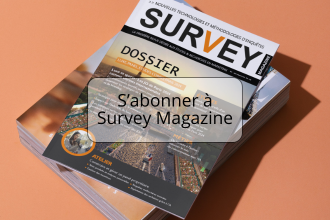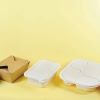A survey with question aims to collect clear and concise information. This information can be different, dealing with tastes and preferences, ways of thinking, feelings or specific details about each individual. In order to catch this distinct information stream, the questionnaire can be made up of different questions types. According to the desired information, the responsible of the survey will favor one question type rather than another. We can distinguish two group of question: the closed questions and the open questions. The first category is used to propose a set of choices chosen by the researcher to respondents. The second one aims to enable the interviewed person to freely answer to the question. Whether open questions benefit more to face-to-face interviews, alone or with a group of people, surveys by phone, on internet or on mobile devices usually use the closed questions in order to make the answers analyzing easier in terms of convenience and of answers treatment. Actually, closed answers enable to automatize the data analysis while answers to open questions need a retyping work and manual treatment.
In this article, we are going to expose the different types of questions by observing which sort of analyses we can make of it and how to present them the better in order to have an attractive questionnaire, especially on the digital supports that give creative opportunities.
Qualitative questions
Qualitative questions with a unique response
Among the different groups of questions used in the surveys, qualitative
questions (one questions type) are the most usual. The interviewed
person is proposed a list of answers and has to choose one or several
responses. This concept of unique or multiple responses must be
highlighted in the survey in order to avoid any ambiguity. The success
of these qualitative questions comes from their easiness to treat and
analyze. The user obtains simple tables or pivot tables from the
respondent people with the different proposed answers. Many statistical
treatments can be easily used and a lot of graphics can enhance the
result presentation (camembert, histogram, curves, horizontal bars, V
box-plot, stairs, areas…).
However, this kind of questions requires planning every possible answer
to the question, or to recodify a posteriori the collected answers named
“others”.
In the qualitative type of question we distinguish several kinds of
questions. The easiest is the dichotomous qualitative question that only
accepts one out of two answers. These answers for that kind of questions
usually are statements or denials such as “yes” and “not” or “true” and
“false” but can also be linked to identification questions such as the
sex.
The qualitative questions with unique multichotomous answers are divided
in two types:
- The first one is the nominal qualitative question aiming to select one
proposition among others. The answer will be a specific information
(example: what is your favorite chocolate brand?). We usually make a
rotation in the responses in order to avoid any influence of the order
on the respondent people and to make them to choose the same variable.
- The ordinal qualitative questions are measurement scales that
enable to know the intensity of a feeling, of an opinion, of a taste…
Usually, an answers order is established from the most positive to the
most negative (for example very satisfied, satisfied, somewhat satisfy,
dissatisfy).
It exists several measurement scales for the ordinal questions such as the Likert scale. This scale is the most known and the most used: it considers the intensity of a feeling, of an attitude face to the stimuli (product, brand, advertisement…). When the answers scale is odd, it allows respondent people to not express a feeling while the pair scales force him/her to make a choice either positive or negative. The researcher can give a note and make the treatment of his/her survey easier. Other scales that are the semantic support scale of Thurstone and the semantic differential scale of Osgood have a more specific utilization. The first one insists more on the intensity of the feeling while the second one opposes two contrary propositions between what the respondent people must place him/herself.
Qualitative question with multiple responses
The qualitative questions with multiple responses can be unlimited or limited. They enable to have a wealth of collection and a certain freedom that can be ambiguous for the respondent people whether it makes him/her to choose unknown answers. It is important to indicate the number of answers allowed to give to the respondent.
Organized qualitative questions
Based on a qualitative question with limited multiple responses, it is
possible to design a hierarchical ranking that enables to put responses
into order to give a preference or importance order to choose by
establishing a minimum and a maximum of responses to give. The usual use
is to classify answers from the best to the worst and to prevent
ex-aequo.
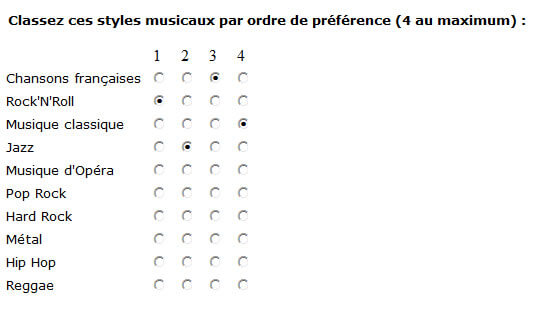
Qualitative questions on a table
Qualitative questions can be grouped in a same table provided that they
have wordings of identical responses. This method enables to obtain a
gain in space that will make the answers typing easier in one hand and
the results treatment in another hand. We usually use it when we ask the
satisfaction degree on a succession of distinct points.

Qualitative questions layout
A meticulous presentation of the questions is the primary condition to the good typing of responses. A qualitative question can have different style. The most known form is the box to tick that is used on all surveys supports and especially the only method for surveys on paper for closed questions. Today, on digital support, surveys software such as NET-Survey enable to bring many different forms for qualitative questions:
- The unwinding list: it enables a gain of space when the responses list
is huge such for identification data (places, ages, jobs...)
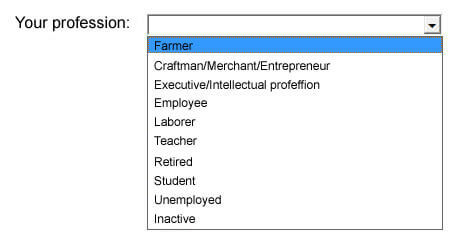
- The slider: it is usually used to give an estimation or an
intensity of opinion or feeling. In this case, the written answer does
not always appear, it is so important to choose the most adapted slider
to your variables.

- The images: answers can be likened to a map image to personalize
the questionnaire and make it funnier. It will be easier to present a
questionnaire to a child when answers are linked to images.
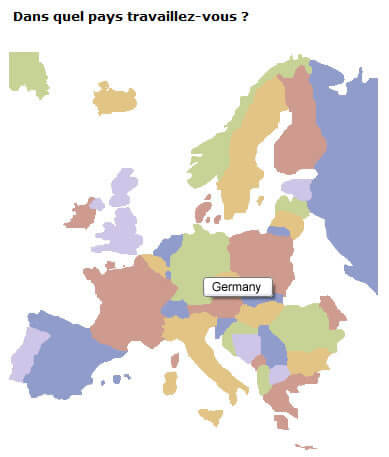
- The slide show: the slide show is a kind of unwinding list with
images. We use it in the same way, what means when we deal with many
answers.
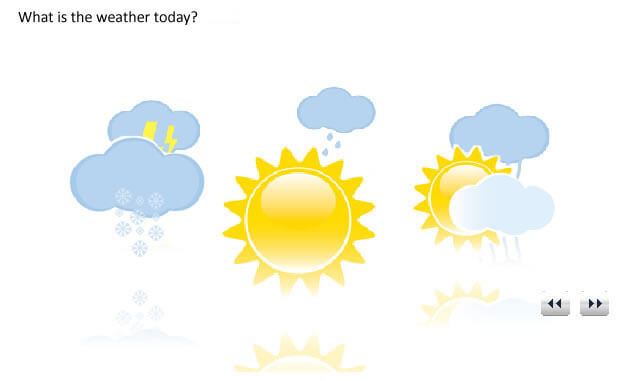
- The button: the answer is included in a clickable button in an
adapted form to tactile supports such as smartphones and digital
tablets.

It exists many other presentations sometimes specific to a question category such as podium for hierarchical ranking. Some surveys software enable to implement audio or video content to the digital questionnaire in order to submit comments or to illustrate the question. We can act on qualitative questions, when they are typed by programming different tools such as scores, quotas, random display or linking between questions according to the chosen answers.
Digital questions
Digital questions are expected to have a numeral answer. It can be a quantity, an age, a price, a note... It is essential to indicate the expected value well and for a note the retained sense (1 can be the best or the worst note) in order to get a valid answer. Do not forget to inform the respondent whether the decimals are authorized or not.
Watch out: before retaining the digital type for a question we must
asking ourselves whether the interviewed people might or would like to
give a precise value to this question. Whether it is a note, it might be
the case. However, for questions such as the age, the income or a
behavior frequency, it is better to propose groups. Digital questions
authorize even more statistical treatments than qualitative variables
(because we can digitally treat them and recodify them into
qualitative).
For digital surveys, some surveys software can present the digital
question in an unwinding bar form with a slider.

Literal questions
Open questions propose to respondent to freely answer to the question by one or several sentences. These questions are usually used by occasional users of surveys who think catching several elements by letting the complete freedom of answer to the interviewed people. But the use of open questions must be safely made because of evident limits that quickly appear:
- Automatic open questions can reveal a lack of survey preparation and a
lack of specification in the aims. Their use reduces the general
relevance of the questionnaire: closed questions are treated with less
comprehensiveness care and less comprehensiveness mind than what it is
needed, because open questions are supposed to bring the information
back that we forgot to search into the closed part of the questionnaire.
- Open questions extend the administration of the questionnaire in
face-to-face or by phone (writing or typing the answers). Researchers
are sometimes tempted to shorten or resume the expressed answers (not
always in a pertinent way).
- When the questionnaire is manually filled by a researcher or even
worse, by the auto-administrated way by the interviewed person, the
typing of hand-written answers often is tedious because of the illegible
answers. Mistakes risks are multiplied.
- Responses rate to automatic open questions generally is extremely
low (10%). It is common to have off-topic answers, incorrectly written
(sometimes incomprehensible) or even without content (ex: « Nothing to
say »)
- In conclusion, the frequent use of « general » open questions in
quantitative surveys (that are far from the essential information)
generate important waste of time and sometime even losses of information
that would have been simple to obtain if the questionnaire had been
better structured.
We will favor the use of closed questions well asked that bring many more exploitable elements than these open questions. Their use must be moderated by reserving them to a free comment at the end of the questionnaire.
The enrichment
But open questions have their utility in quantitative surveys. Open
questions must be wisely used, aiming to finish structuring the
information.
When we propose an items list (used brand, frequented store, searched
characteristic, original country) proposing an answer such as « Other,
must be precised... » enables to collect additional items initially not
planned. The initial list usually is incomplete because it was
impossible to sweep all the universe of possible answers along. In this
case, the question is half-open (or half-closed). Surveys software such
as Ethnos and Net-Survey enable to manage the dynamical addition of the
new answers during the typing. The functionality is called « Enrichment
». An answer added in this way will be proposed during the typing of the
next questionnaire with different spelling. Coding is directly made (in
live) and enriched questions can be treated like other closed
questions.
Of course, it is usually possible to see the added responses again to
eventually proceed to a group before the treatment.
Date and hour type of question
Date questions type
Date questions type, while having an obvious utilization can be really
useful during the answers treatment stage to proceed to inter-waves
sorting for instance. Software such as Ethnos or Net-Survey enable to
automatically register the date (during the responses validation
process) by choosing the server post or customer post, which is useful
if time difference happens. The date question can take the precise date
into account with a selection with the help of a calendar, the years,
the month or the day or accept answers in a precise interval.
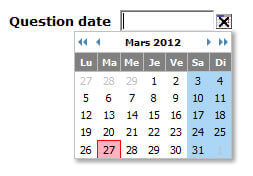
Hour questions type
The hour question type processes the same characteristics such as the automatic registering from a server post or a customer post. But its utility is different because it can give information about the hour typed or indicate the typing time of the respondent people by placing two hour questions to each end of the questionnaire.
Calculated questions
The calculated type corresponds to a more advanced utilization, especially useful in the case of questionnaires administrated and directly typed by phone, on Internet or even on mobile devices such as smartphones and digital tablets. Calculated questions type automatically take values according to the given answers to the previous questions and that can enable to orientate the following of the questionnaire. So, we can ask a person, who gave really bad evaluations to an item set, to give more details about what motives his/her negative review. Date and hour questions can be automatic and hidden in order to calculate the average time of the questionnaire administration for instance.



